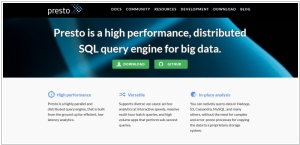Presto vs Vertica
May 24, 2023 | Author: Michael Stromann
7
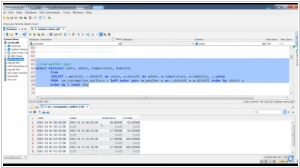
Vertica offers organizations new and faster ways to store, explore and serve more data. Vertica lets organizations store data in a cost-effectively, explore it quickly and leverage well-known SQL-based tools to get customer insights. By offering blazingly-fast speed, accuracy and security, it offers operational advantages to the entire organization.
See also:
Top 10 Big Data platforms
Top 10 Big Data platforms
Presto and Vertica are both popular database technologies, but they have significant differences in their architecture, query processing, and target use cases. Presto is an open-source distributed SQL query engine designed for running interactive, ad-hoc queries across various data sources. It excels at handling large-scale data processing and offers high query performance through its distributed processing capabilities. Presto supports a wide range of data formats and is often used for analytics and exploration in data lakes. Vertica, on the other hand, is a commercial columnar database optimized for high-performance analytics. It is designed to handle massive amounts of structured data, providing fast query performance and compression techniques for efficient storage. Vertica is commonly used in data warehousing scenarios where rapid analytics on structured data are required.
See also: Top 10 Big Data platforms
See also: Top 10 Big Data platforms
Presto vs Vertica in our news:
2019. Starburst raises $22M to modernize data analytics with Presto
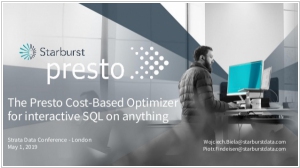
Starburst, the company seeking to commercialize the open-source Presto distributed query engine for big data (originally developed at Facebook), has announced a successful funding round, raising $22 million. The primary objective of Presto is to enable anyone to utilize the standard SQL query language for executing interactive queries on vast amounts of data stored across diverse sources. Starburst intends to monetize Presto by introducing several enterprise-oriented features. These additions will primarily focus on enhancing security, such as role-based access control, and integrating connectors to enterprise systems like Teradata, Snowflake, and DB2. Additionally, Starburst plans to provide a management console that empowers users to configure the cluster for automatic scaling, among other functionalities.
2016. HP to sell its software business to Micro Focus
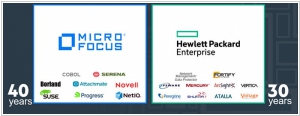
Hewlett-Packard Enterprise (HPE) has reached an agreement to sell its software business to Micro Focus in a substantial $8.8 billion deal. One significant component of HP Enterprise software, Autonomy, constitutes a quarter of the total value and was initially acquired by HP for $11 billion in 2011. The software business being sold also encompasses Mercury Interactive, which HP acquired for $4.5 billion in 2006, Vertica for $320 million, and ArcSight for $1.5 billion in 2010. HPE's Chief Executive, Meg Whitman, intends to shift the company's focus towards other sectors such as networking, storage, and technology services following its separation from computer and printer manufacturer HP Inc. in the previous year.
2014. HP plugs the Vertica analytics platform into Hadoop
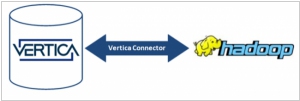
HP has unveiled the introduction of Vertica for SQL on Hadoop, a significant announcement in the world of analytics. With Vertica, customers gain the ability to access and analyze data stored in any of the three primary Hadoop distributions: Hortonworks, MapR, and Cloudera, as well as any combination thereof. Given the uncertainty surrounding the dominance of a particular Hadoop flavor, many large companies opt to utilize all three. HP stands out as one of the pioneering vendors by asserting that "any flavor of Hadoop will do," a sentiment further reinforced by its $50 million investment in Hortonworks, which currently represents the favored Hadoop flavor within HAVEn, HP's analytics stack. HP's announcement not only emphasizes the platform's interoperability but also highlights its capabilities in dealing with data stored in diverse environments such as data lakes or enterprise data hubs. With HP Vertica, organizations gain a seamless solution for exploring and harnessing the value of data stored in the Hadoop Distributed File System (HDFS). The combination of Vertica's power, speed, and scalability with Hadoop's prowess in handling extensive data sets serves as an enticing proposition, potentially motivating hesitant managers to embrace big data initiatives confidently. HP's comprehensive offering provides a compelling avenue for organizations to unlock the potential of their data, urging them to venture beyond their reservations and embrace the world of big data.
2014. HP Vertica introduces SQL-on-Hadoop
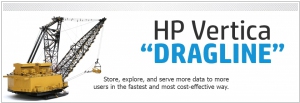
HP's Big Data platform, Vertica, has recently undergone an update to its new version, 7.1, codenamed "Dragline." This release brings forth several enhancements including SQL-on-Hadoop capability, improved access control, optimized backups, expanded support for Flex Zone data formats, dynamic resource management, and more. The standout feature in this version is the ability to execute SQL queries directly on Hadoop Distributed File System (HDFS) without the need for connectors. However, for faster and in-depth analytics, the data would still need to be moved into Vertica. It is worth noting that, as mentioned in a previous post about SQL-on-Hadoop, MapR and Vertica can be operated on the same hardware, leading to cost savings and improved integration between the two platforms.

